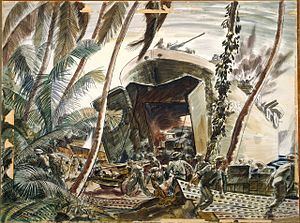6,574 men6 destroyers32 aircraft 231+ men49 planes Dates 27 Oct 1943 – 12 Nov 1943 | 226 casualties 223 dead8 POW Result Allied strategic victory | |
 | ||
Similar World War II, Raid on Choiseul, Battle of the Green Islands, Land Battle of Vella Lavella, Solomon Islands campaign | ||
Battle of the treasury islands
The Battle of the Treasury Islands was a Second World War battle that took place between 27 October and 12 November 1943 on the Treasury Islands group, part of the Solomon Islands. The battle formed part of the wider Pacific War and involved New Zealand and US forces fighting against Japanese troops. The majority of the ground forces were provided by the New Zealand 3rd Division.
Contents
The Allied invasion of the Japanese held island group intended to secure Mono and Stirling Islands so that a radar station could be constructed on the former and the latter be used as a staging area for an assault on Bougainville. The attack on the Treasury Islands would serve the long term Allied strategy of isolating Bougainville and Rabaul and the elimination of the Japanese garrison in the area.
Operation
As part of the Allied strategy of isolating Bougainville and Rabaul and eliminating the large Japanese garrison in the area, in late 1943, as the Solomon Islands campaign progressed, the Allies decided to launch an attack on the Treasury Islands. The invasion, to be conducted primarily by the New Zealand Army, supported by American forces, was codenamed Operation Goodtime. For the operation, the New Zealand 8th Infantry Brigade Group, commanded by Brigadier Robert Row and part of the New Zealand 3rd Division, was assigned to the United States' III Amphibious Force, which assigned its Southern Force under Rear Admiral George H. Fort for the operation.
The Allies launched the invasion of the Treasury Islands at 06:06 hours on 27 October. A total 3,795 men landed in the assault wave with the remainder of the Allied force landing in four waves during the following 20 days, to reach a total of 6,574 men. The operation was the first amphibious assault launched by New Zealand troops since the Battle of Gallipoli in 1915. It was the second combat operation undertaken by the New Zealanders in the Pacific, following the Land Battle of Vella Lavella, which had taken place the previous month.
Commencing on 27 October, two infantry battalions – the 29th and 36th – landed around Falamai, on the southern coast of Mono Island, approximately 2 miles (3.2 km) away from Blanche Harbour's western entrance. Meanwhile, a detachment from a third infantry battalion, the 34th, landed on Stirling Island, to the south of Mono, while another detachment from the 34th skirted around the western side of the island and landed to the north around Soanotalu, to provide security for a radar station that would be installed there. Over the course of several hours, the beachhead around Falamai was secured amidst sporadic resistance from the Japanese and then over the following days patrols were sent out to clear the island. On 1 November the flag was raised over the ruins of Falamai, the islands' capital, and civil administration was restored. Eleven days later the islands were declared clear of Japanese forces; although Japanese holdouts were sighted in the jungles into January 1944.
Aftermath
The operation, in conjunction with Operation Blissful, served to divert the attention of the Japanese Seventeenth Army from the next major Allied target in the Solomon Islands campaign. The success of the operation also helped to improve the planning of subsequent landings in the Pacific. The New Zealanders' next combat operation would be the Battle of the Green Islands, in early 1944. Casualties during the operation amounted to 226 for the Allies, consisting of 40 New Zealanders killed and 145 wounded, and 12 Americans killed and 29 wounded. The Japanese lost 223 killed and eight captured.
